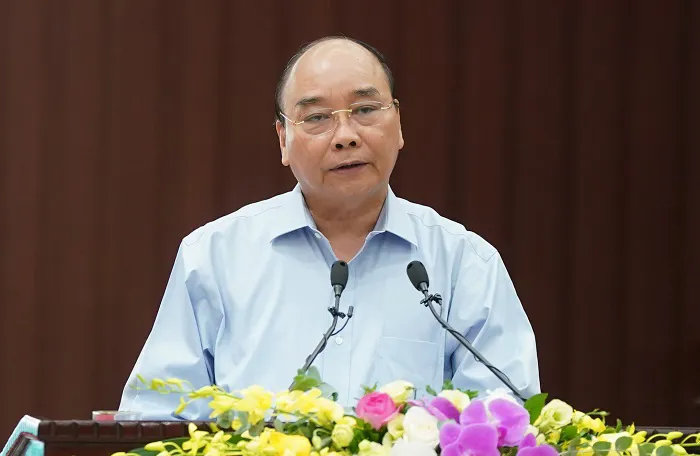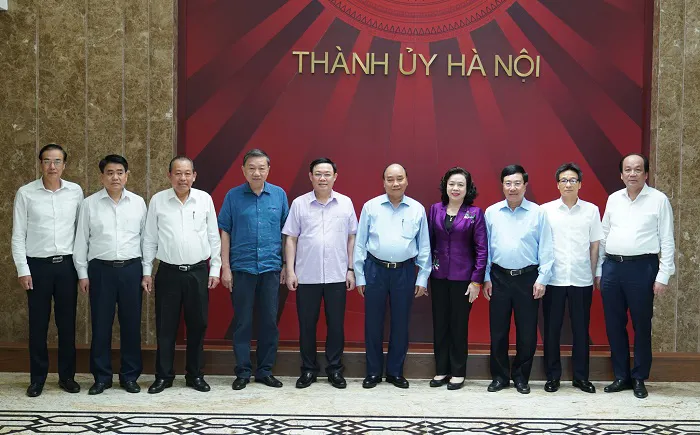PM urges Hanoi to soon achieve upper-middle income level status
Hanoi should set a vision to compete with other capital cities in the world such as Beijing, Bangkok, or Kuala Lumpur, said Prime Minister Nguyen Xuan Phuc.
Prime Minister Nguyen Xuan Phuc has urged Hanoi to achieve the income per capita of US$8,100 – 8,300, the threshold of upper-middle income level, much sooner than the timeline of 2025 set by the city’s leaders.
| Prime Minister Nguyen Xuan Phuc at the meeting. |
Meanwhile, Mr. Phuc agreed with Hanoi’s target of completing the industrialization and modernization process by 2030, paving the way for the capital city to become a global city with high living standards and the gross regional domestic product (GRDP) per capita at US$36,000 per annum by 2045.
In 2019, Hanoi’s nominal GRDP stood at VND971.7 trillion (US$42.04 billion) and GRDP per capita at VND120.1 million (US$5,196), up 7% year-on-year and higher than the national GDP per capita of US$4,791.
The finalization of a special financial mechanism for Hanoi, which gives the city greater autonomy in major development issues, would help it attract more resources for further development, Mr. Phuc said at a meeting with Hanoi’s leaders on August 7.
| Prime Minister Nguyen Xuan Phuc (middle) along with senior officials of the government and Hanoi. |
What major cities such as Hanoi and Ho Chi Minh City lack at the moment are not financial means or resources, but appropriate supporting policies for efficient utilization of all resources at their disposal, Mr. Phuc added, saying better management of land resources would help Hanoi finance key priority infrastructure projects.
For the city’s development objectives in the 2020 – 2025 period, Mr. Phuc suggested Hanoi should not aim at competing with Ho Chi Minh City, but with other capital cities globally, such as Bangkok, Kuala Lumpur, Beijing, among others.
According to Mr. Phuc, this is not a vision for the next five years, but for longer terms of 10, 15 or even 20 years.
During the 2015 – 2020 period, Hanoi has been among the country’s fastest growing localities with average GRDP growth of 7.39% and modern structural economy, in which the agricultural sector only accounts for 2% of GDP.
Despite making up only 1% of the country’s land and 8.5% of the population, Hanoi contributes 18% to the country's budget revenue and 16% of GDP annually.
Based on preliminary data from the first half of 2020, Hanoi’s authorities have devised two growth scenarios for the remaining six months of the year.
In the first scenario and also the most optimistic one, Hanoi could achieve a growth rate of 5.9% in 2020, 1.3 times the nation’s optimistic growth scenario of between 4.4 and 5.2%, if growth rates in the third and fourth quarters reach 7.8% and 8.4%.
In a second scenario, Hanoi’s GRDP would expand 5.4%, 1.3 times the nation’s neutral growth scenario of 3.6 – 4.4%, if the city’s economy expands 6.9% and 7.4% in the third and fourth quarters, respectively.
Secretary of Hanoi’s Party Committee Vuong Dinh Hue said the city targets an economic growth rate at 1.3 times the national average and strives to fulfill the state budget revenue targets set by the National Assembly for this year.













